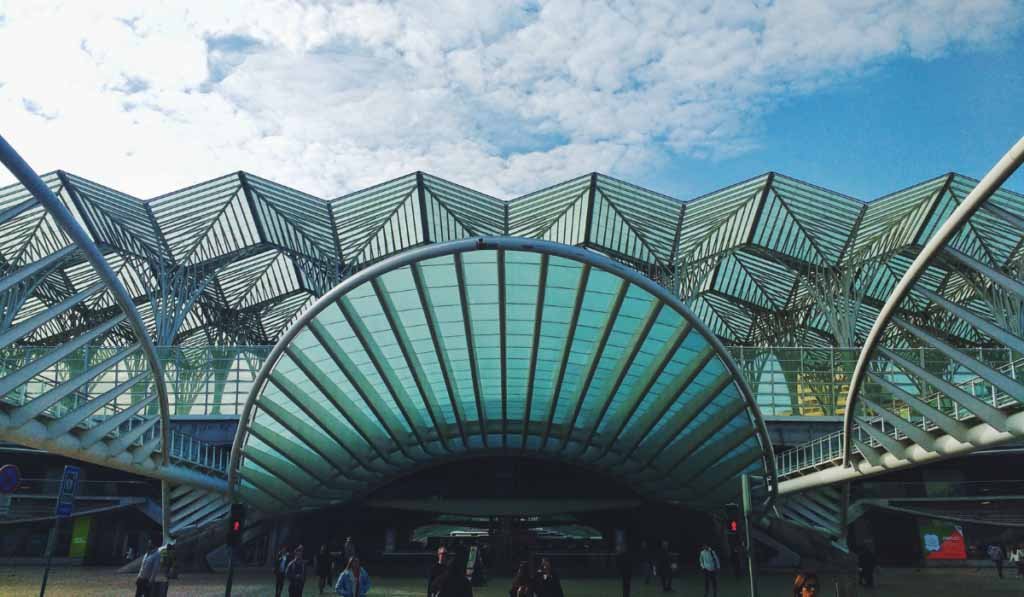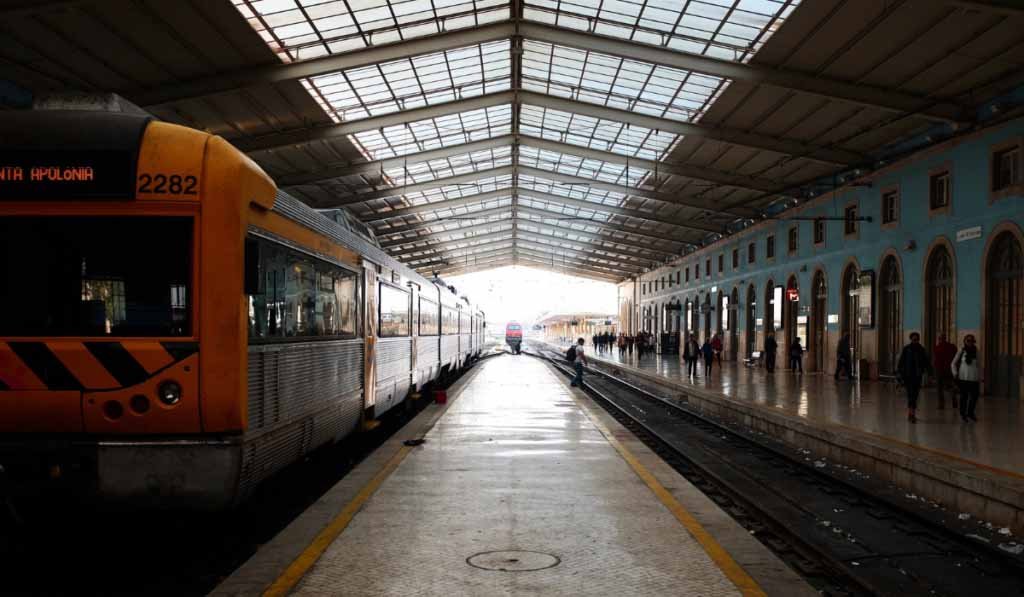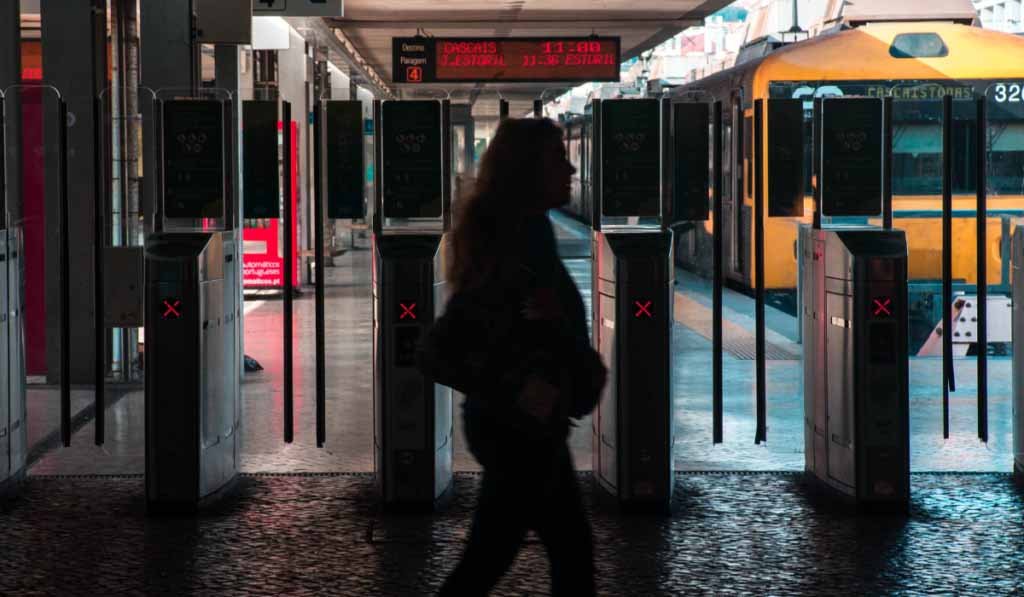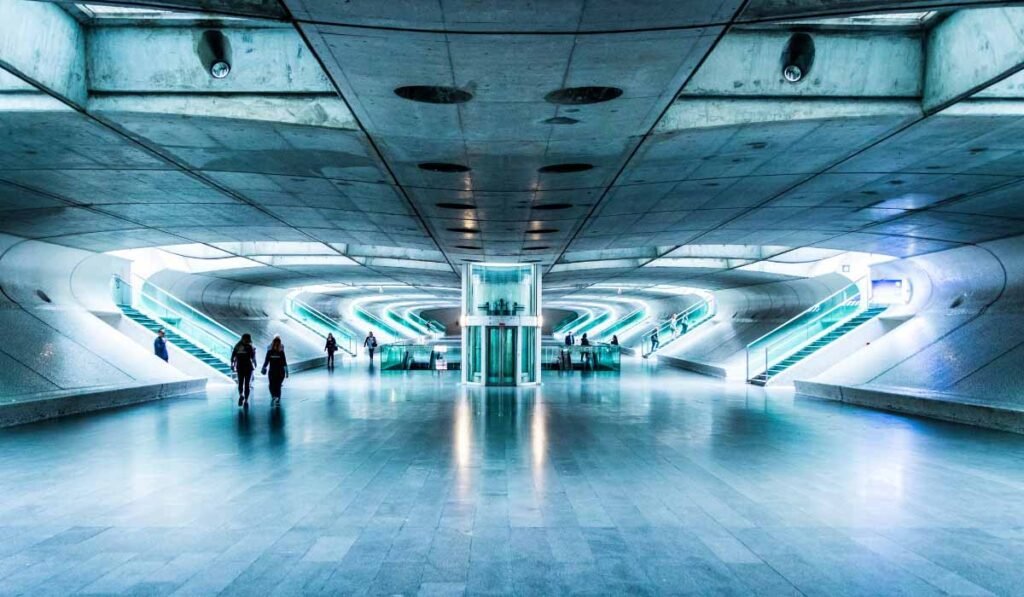Welcome to Lisbon! Whether you’re arriving or departing, you’ll likely need to navigate the city’s main train stations at least once, whether you’re heading up north to explore the Douro Valley or are taking a day trip to Sintra.
The great news is that Lisbon’s train stations are easy to navigate, and we’ve taken enough trips in and out of the city that we’re here to guide you through what to do, including how to buy tickets, understand train schedules, and your transportation options when arriving to or departing from the station.
What Are the Main Train Stations in Lisbon?
There are several rail hubs in Lisbon that send trains to various destinations across the country and to other parts of Europe.
For example, while Oriente is a massive transit hub in the northeast part of Lisbon near the airport, it’s not the main train station you’d take to get to places like Sintra or Cascais.
Basically, the train station in Lisbon you need to leave from (or arrive at) will largely depend on your final or starting destination.
The most commonly used train stations in Lisbon are:
Other smaller stations nearby include Belém train station, which is just west of Lisbon’s city center, the Sintra train station, which is where you arrive before exploring the enchanting fairytale city of Sintra, and Campolide. Before exploring the smaller train stations, here’s a brief breakdown of the most popular rail hubs within Lisbon to help you plan your journey.
Discover Cheap Hotels in Lisbon
Also Read: The Best Day Trips From Lisbon
Oriente Train Station

Oriente is a super modern transportation hub located in the district of Parque das Nações, Lisbon. The station building was designed by renowned Spanish architect Santiago Calatrava and was completed in time for the 1998 Lisbon Expo. It’s architecturally impressive, making it a popular spot for Instagrammable photos in Lisbon, even if you don’t need to hop on a train to somewhere else.
Inside the station, you’ll find a Lisbon Metro stop, too, which is part of the Linha Vermelha or Red Line, and a suburban train station on the Azambuja Line that connects to Santa Apolónia, Alverca, Vila Franca de Xera, and Azambuja.
The Sintra Line also connects Gare do Oriente with Roma Areeiro, Entrecampos, Sete Rios, M. Abraão, Campolide, and Sintra. The station offers connections to various cities, including the quickest trains from Gare do Oriente, which take about 2 hours and 35 minutes to get to Porto’s Campanha Station (it’s the train station we use when traveling from Lisbon to Porto by train).
Tip: The Oriente train station is serviced by the Oriente metro stop. All of Lisbon’s major train stations are actually serviced by corresponding metro stops (Oriente, Santa Apolónia, Cais do Sodré, Rossio, etc.), making it easy to arrive at any train station via public transportation.
Also Read: How to Get From Lisbon to Porto by Train
Santa Apolónia Train Station

Located in the historical Alfama district of Lisbon, the Santa Apolónia train station is the oldest railway station in the city. It was constructed in 1865 on the grounds of a former convent, making it a subject of interest for those keen on exploring historical architecture. The station operates Comboios de Portugal (CP) trains to popular destinations, including Paris, Madrid, and Porto.
Santa Apolónia is also a transportation hub with a connecting metro stop (appropriately named Santa Apolónia, which is the last stop on the Blue Line), bus stops, and taxi stands. Visitors to Lisbon will find the station a great starting point for their journey, thanks to its proximity to various attractions such as the Museu Militar, Museu do Fado, and the Museu Nacional do Azulejo.
Tip: If you’re traveling light and arrive at this train station ready to explore, you can enjoy a leisurely 20-minute walk to Praça do Comércio, one of Europe’s largest squares and the beating heart of the city.
Sete Rios Train Station

Similar to the Oriente Station, Sete Rios is a bustling transportation hub located in the northern part of Lisbon that caters to both long-distance and local buses. It is also a part of the blue line of the Lisbon Metro, which can be accessed through the Jardim Zoológico station.
Apart from buses and the metro that runs through it, the Sete Rios train station also offers convenient travel options for those who are planning to explore other parts of Portugal, such as Faro, Setubal, and Beja. Fertagus operates frequent trains that run from Sete Rios to Setubal, a city across the Tagus River, while other trains can take you all the way to Faro in Algarve, the southernmost region of Portugal.
The station also offers trains to Mira Sintra-Meleças, Torres Vedras, Obidos, Caldas da Rainha, and Leiria on the Linha do Oeste. While it doesn’t affect the travel experience, it’s worth noting that the Sete Rios train station isn’t as modern as Oriente, but there are small cafes and even a decent-sized Aldi inside the station where you can grab snacks before your trip.
Tip: The Sete Rios train station in Lisbon is the best option for travelers looking to take a quick trip across the Tagus River to popular beach destinations like Setubal.
Rossio Train Station

Located in the heart of the city, Rossio train station is a prime example of the Neo-Manueline style of architecture. Built in the late 1800s, it exudes grandeur and elegance with its horseshoe-shaped arches and beautiful clock. It serves as a transport hub for buses, metros, taxis, and trams, making it an essential part of Lisbon’s public transportation network.
The station is a gateway to Sintra, with trains departing for the Sintra Station every 15 minutes on weekdays and every 30 minutes on weekends. It takes about 40 to 45 minutes to travel between Lisbon and Sintra, making it a convenient and efficient way to explore the stunning town of Sintra.
Visitors can easily access Rossio Station via the metro stations of Rossio and Restauradores, with the latter station having pedestrian connections to Rossio. Like Oriente, the Rossio train station in Lisbon is a pretty great spot to snap photos.
There is also a Starbucks just inside the entrance of the Rossio train station. We suggest stopping in for a coffee and pastry here before taking the escalators up to the train (although it gets packed in the evenings). Starbucks has a restroom you can use, but you often need a passcode, which you can only get if you purchase something (it’ll be on the receipt).
Tip: The Rossio train station in Lisbon is the best option for travelers going to Sintra. It’s also a great spot to snap photos, as the outside arches are ornate and beautiful.
Cais do Sodré Train Station

The Cais do Sodré train station is accessible via the Lisbon metro’s Green Line and a suburban train station on the Cascais Line. This train line is essential for anyone wanting to visit the beach, offering a scenic 30-minute ride along the Atlantic Ocean as it passes through a range of popular coastal towns, such as Estoril, before ending in the resort town of Cascais.
During the summer months, the Cascais line is always busy, especially with vacationers keen to soak up the sun, sand, and sea. For anyone taking this train, we recommend sitting on the left side when leaving Lisbon to enjoy breathtaking coastal views. The Cais do Sodré Station is also the departure point for ferries crossing the River Tagus to Cacilhas, Seixal, and Montijo.
Tip: This train station is just in front of the Time Out Market. Take advantage of the proximity and walk across the street to sample some food.
Other Popular Train Stations Near Lisbon
While the Lisbon train stations mentioned above are great for traveling to other cities near or far, there are smaller train stations near the heart of Lisbon most travelers will explore during their adventures in Portugal’s capital city.

Belém Train Station
The Belém train station is situated on the Cascais Line, a railway that connects Cais do Sodré and Cascais. Not only is it a convenient location to start exploring Belém’s attractions, but it’s also near other points of interest, such as:
- Estação Fluvial de Belém
- Museu Nacional dos Coches
- MAAT
- Monasterio de los Jerónimos
Add some excitement and adrenaline to your day, and rent a scooter to explore Belém. You’ll find plenty available near the train station to use with apps like Bolt.
Sintra Train Station
The Sintra station is a charming transportation hub that offers access to several destinations. Situated at Avenida Dr. Miguel Bombarda, this train station has been serving passengers since 1887. The station’s walls are adorned with eye-catching azulejos tile work, and its proximity to the town center makes it an ideal starting point for exploring Sintra’s historic attractions.
Important Note: When you take the train from Lisbon to Sintra, there are two Sintra stops on the map. Get off at the one that says “Sintra.” There is another stop you’ll see on train maps that says “Portela de Sintra.” The regular Sintra stop is where you can find a taxi, tuk-tuk, or walk to the city center.
From the station, visitors can take a bus or taxi or take a leisurely walk of just over 1km to reach the city center. Aren’t interested in exploring this fairytale town? The station connects to Rossio, Oriente, Entrecampos, Sete Rios, and Campolide via the Sintra Line.
Cascais Train Station
The Cascais train station is located at the end of the Cascais Line, which runs from Lisbon’s Cais do Sodré Station. If you want to travel between Cais do Sodré, Estoril, and Cascais, you can catch a train at this station.
The trip from Cais do Sodré Station to Cascais usually takes around 30 to 40 minutes, and tickets must be purchased prior to boarding the train. As mentioned above, you can purchase these at convenient ticketing machines at the train station.
How to Buy a Train Ticket in Lisbon
Buying a train ticket in Lisbon is easy and convenient. You can purchase a ticket at the vending machines or ticket offices in the train stations. The vending machines have clear instructions in English, which makes it easy for tourists to purchase tickets.
If you’re traveling during the summer, be prepared for long queues at the vending machines and ticket offices. To avoid any inconvenience, we recommend you arrive well in advance of your planned departure. This is especially true for popular routes such as Lisbon to Sintra. While you might snag a ticket, if it’s crowded, you could have to stand the entire way.
You can also buy your tickets online at the official website of Comboios de Portugal. The online ticket office allows you to buy Alfa Pendular, Intercidades, and add-on Regional, Oporto, and Coimbra urban trains tickets up to 60 days in advance.
If you’re sure of your travel times, we recommend purchasing tickets for longer trips well in advance.
Transport From Lisbon Train Stations
- Metro & Bus: The metro system in Lisbon is fast and efficient, with lines running throughout the city center as well as outlying areas such as Sintra or Cascais. Additionally, there are numerous bus routes available which offer an economical way of getting around town if time isn’t an issue for you. All of the train stations mentioned above are connected directly by corresponding metro lines (including Sete Rios, which is connected by the Zoológico metro stop).
- Taxis: Taxis are also available from all main railway hubs mentioned above should you wish to travel more quickly than public transport allows. Just remember that fares will be higher than if taking public transport. It’s important to note that Uber in Portugal is also widely available, as are Bolt and other ridesharing apps.



